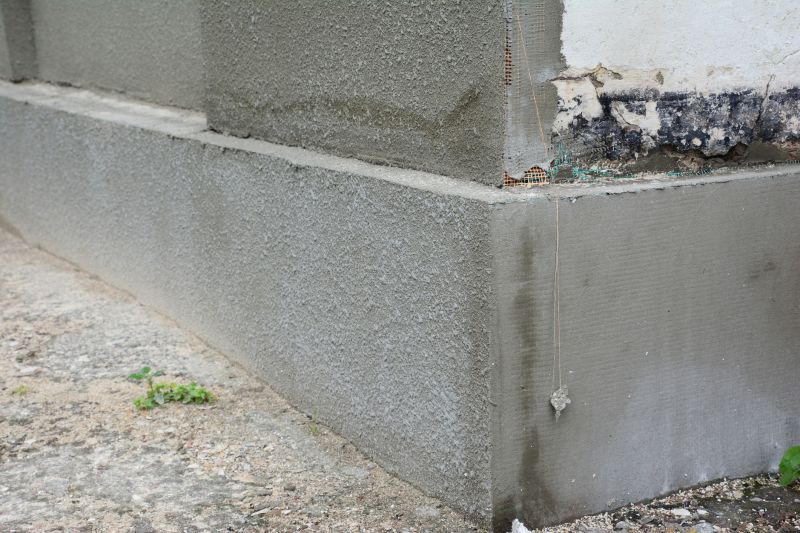Top-Rated Foundation Repair Products To Reinforce Your Home’s Base
Identify high-quality solutions designed to address foundation issues and ensure your home remains secure and stable.
 Foundation stability is essential for the safety and longevity of any structure. When signs of foundation issues appear, such as cracks in walls, uneven flooring, or doors that do not close properly, it may be time to consider repair solutions. Various products are available to address these concerns, each designed to support or stabilize the foundation effectively. Choosing the right products depends on the specific issues, soil conditions, and the extent of the damage.
Foundation stability is essential for the safety and longevity of any structure. When signs of foundation issues appear, such as cracks in walls, uneven flooring, or doors that do not close properly, it may be time to consider repair solutions. Various products are available to address these concerns, each designed to support or stabilize the foundation effectively. Choosing the right products depends on the specific issues, soil conditions, and the extent of the damage.
Top Overall Option
Polyurethane Foam Injection System
Polyurethane foam injection systems are versatile and minimally invasive options for addressing small to moderate foundation settling or cracking. They work by expanding beneath the foundation to lift and stabilize affected areas, providing a quick and effective solution without extensive excavation. These systems are especially useful for filling voids and sealing cracks, helping to prevent water intrusion and further deterioration.
Types of Products For Foundation Repairs
Hydraulic Push Piers
Used to lift and stabilize sinking foundations by transferring the load to stable soil layers deep below the surface.
Helical Piers
Rotated into the ground to provide support in areas with challenging soil conditions, ideal for underpinning and stabilization.
Polyurethane Foam Injection
A quick, minimally invasive method to fill voids and lift settling foundations, suitable for small cracks and void filling.
Carbon Fiber Reinforcement
Applied to walls to reinforce and prevent further cracking or bowing, often used for basement wall stabilization.
Mudjacking / Slab Jacking
A process that lifts sunken concrete slabs by injecting a grout mixture beneath them, restoring level surfaces.
Underpinning Systems
Includes various methods like piering and piling to strengthen and stabilize the foundation beneath existing structures.
Soil Stabilization Products
Chemical or mechanical solutions designed to improve soil bearing capacity and reduce settlement issues.
Waterproofing Membranes
Applied to basement walls and foundations to prevent water infiltration and reduce hydrostatic pressure.
Foundation Braces and Wall Anchors
Support systems used to stabilize bowing or leaning basement walls and prevent further movement.
Epoxy Injection Kits
Used to seal and reinforce cracks in concrete, restoring structural integrity and preventing water ingress.
Drainage Systems
Includes french drains and sump pumps to manage water around the foundation and reduce soil erosion.
Grout and Sealants
Seal cracks and joints to prevent water penetration and further deterioration of the foundation.
Vapor Barriers
Installed in basements to control moisture and reduce humidity that can affect foundation stability.
Popular Choices
Commonly used for underpinning and stabilizing settled foundations, suitable for various soil conditions.
Widely chosen for quick repairs and void filling, especially for minor settlement issues.
Effective for stabilizing bowing basement walls and preventing further movement.
Popular for sealing cracks in concrete and restoring structural integrity in a minimally invasive manner.
Used to lift and level sunken concrete slabs, often in driveways and walkways.
French drains and sump pumps are frequently installed to manage water flow around foundations.
Chosen for basement wall stabilization and crack reinforcement due to its strength and ease of application.
Selected for deep foundation support in challenging soil conditions or significant settlement.
Commonly installed to prevent water intrusion and protect foundation walls.
Used for sealing cracks and joints to prevent water ingress and further damage.
Foundation repair products can range from simple epoxy injections to complex underpinning systems. They are often used in conjunction with professional assessments to ensure that the selected solutions are appropriate for the problem at hand. Proper installation and quality materials are crucial for achieving durable results that help prevent further damage and maintain the structural integrity of the building.
In addition to repair products, there are also preventative options available that can help reinforce the foundation before issues develop. These include soil stabilization solutions, waterproofing membranes, and foundation braces. When considering foundation repair products, it’s important to evaluate the long-term effectiveness, ease of installation, and compatibility with existing structures. Consulting with foundation specialists can help determine the most suitable options for your specific situation.
Olathe residents seeking foundation repair solutions should prioritize products that are well-suited to local soil and weather conditions. Properly chosen and installed products can contribute significantly to the stability and safety of your property, ensuring peace of mind for years to come.
Key Buying Considerations
- Assess the extent and type of foundation damage to determine appropriate repair solutions.
- Consider the soil conditions and drainage around your property, as they influence product effectiveness.
- Evaluate whether the product is suitable for your specific foundation type, such as basement walls, slabs, or piers.
- Check the installation requirements and whether professional assistance is recommended or necessary.
- Review the long-term durability and maintenance needs of the repair products.
- Ensure compatibility of repair products with existing foundation materials and structures.
- Consider the ease of access to the repair site and whether temporary disruptions will be minimal.
- Research the product’s ability to prevent water intrusion and manage moisture levels.
- Evaluate the product’s capacity to accommodate future movement or settlement without failure.
- Look into warranty options and the reputation of the manufacturer or supplier.
- Determine if the product can be integrated with other foundation stabilization or waterproofing solutions.
- Assess costs in relation to the extent of repair needed and potential property value impact.
- Verify that the product complies with local building codes and standards.
- Consult with foundation specialists or structural engineers for expert guidance.
